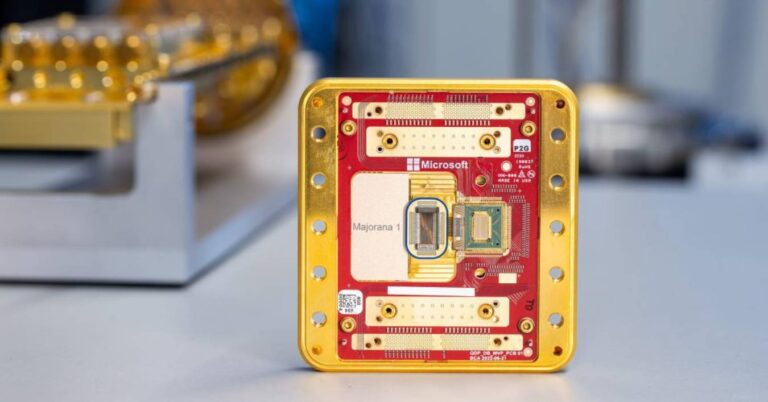Microsoft’s Majorana 1 quantum chip represents a pivotal advance in topological qubit research, promising scalable, error-resistant quantum computing. However, skepticism persists among physicists due to limited technical transparency and unresolved questions about definitive proof of Majorana quasiparticles—a critical hurdle for validating its revolutionary claims.

Microsoft Introduces the Majorana 1 quantum chip – Key Points
- Majorana 1 Chip Introduction:
- Microsoft unveiled the Majorana 1 quantum chip in February 2025, marking a milestone after nearly 20 years of research into topological qubit technology.
- The chip employs a topological superconductor design, utilizing indium arsenide (a semiconductor) and aluminum (a superconductor) to create stable, error-resistant qubits. This approach hinges on achieving a topological state of matter, a phase distinct from solids, liquids, or gases, which Microsoft claims is essential for its scalability.
- Central to this design is the world’s first topoconductor, a novel material that creates this new state of matter. This topoconductor enables the production of quick, small, reliable, and scalable qubits, addressing the fragility and error-proneness that have historically limited quantum computing. Microsoft believes this topoconductor could be as transformative as the semiconductor was for classical computing, potentially revolutionizing the field.
- Microsoft asserts this design can scale to one million qubits on a single chip—small enough to fit in the palm of a hand—potentially addressing complex global challenges like microplastic degradation and self-healing materials. The company emphasizes that this scale is the threshold for quantum computing to surpass all classical computers combined in computational power, with the Majorana 1 chip (a gold and red square in press images) offering a path to industrial-scale problem-solving in years rather than decades.
- Currently, the Majorana 1 chip hosts eight topological qubits, with ambitious plans for expansion, though it remains a research prototype rather than a commercially available product. Microsoft highlights this as a starting point, with a clear roadmap to scale up significantly.
- Technical Advancements & Skepticism:
- Topological State of Matter Breakthrough:
- The chip’s innovation lies in creating a new state of matter by combining indium arsenide and aluminum at the atomic level. This process, described by Microsoft as “incredibly hard,” involves spraying materials atom by atom to ensure perfect alignment, enabling the material stack to exhibit topological properties when cooled to extremely low temperatures.
- This topological state underpins the qubits’ inherent error protection and allows digital control via microwaves, distinguishing it from other quantum approaches that rely heavily on error correction.
- Current prototypes feature eight topological qubits, with Microsoft aiming to scale this dramatically to reach the million-qubit goal.
- Krysta Svore, a Microsoft technical fellow, noted that understanding these materials is so complex that it paradoxically requires a quantum computer, suggesting that a scaled quantum system could design even better materials for future quantum advancements.
- Nanowire Device:
- The chip uses a superconducting nanowire to host Majorana quasiparticles, topological states theorized to store quantum information with exceptional stability due to their braided-rope-like arrangement.
- Experiments published in Nature detected an extra electron in the nanowire—a precursor to Majorana states—but do not conclusively confirm their existence. A new paper in Nature details the chip further, but uncertainties persist.
- Follow-up experiments paired two nanowires in a superposition, claiming to demonstrate qubit functionality. However, critics argue this falls short of proving topological protection, a cornerstone of Microsoft’s claims.
- The Majorana 1 chip integrates error resistance at the hardware level, requires no analog tuning, and is compact enough to fit in a palm-sized device.
- Broader Technical Integration:
- Microsoft’s Azure Quantum platform merges AI, high-performance computing, and quantum systems, potentially enabling AI models to “speak nature’s language” for instant material design, a capability that could accelerate innovations in fields like drug discovery and material science.
- Skepticism from the Scientific Community:
- A 2021 Microsoft-funded study on Majorana states was retracted due to irreproducible results, casting a shadow over current claims and fueling doubts about their validity.
- Physicists like Steven Simon from the University of Oxford acknowledge progress but caution, “There’s no slam dunk to know immediately from the experiment.”
- Dr. Michael Jarret, associate director of George Mason University’s Quantum Science and Engineering Center, told CNBC that while Majorana particles are theoretically robust against errors—a key bottleneck in quantum scaling—their existence in Microsoft’s setup remains an “outstanding question.” He views the advancement as significant but notes it leaves “a lot of questions” unanswered.
- Peer reviewers of Microsoft’s latest paper were similarly cautious. One described the work as resting on “extremely fragile ground,” while another questioned the certainty of its connection to Majorana physics, urging “serious scrutiny.”
- Additional expert opinions reflect cautious optimism:
- Paul Stevenson, a professor of physics at the University of Surrey, said Microsoft could be “very serious competitors” in the quantum race if they build on this research, but noted that “the next steps are difficult” and it’s too early to be more than “cautiously optimistic.”
- George Booth, a professor of theoretical physics at King’s College London, called the research an “impressive technical achievement” but emphasized that its true value will only be clear in hindsight, questioning whether claims of quantum computers arriving in “years” rather than decades can be substantiated.
- Chetan Nayak, a technical fellow of quantum hardware at Microsoft, countered skepticism by stating, “I think that this brings us into years rather than decades,” shaking up conventional thinking about quantum timelines and reflecting Microsoft’s confidence in the topoconductor’s potential.
- Travis Humble, director of the Quantum Science Center at Oak Ridge National Laboratory, agreed that Microsoft could deliver prototypes faster but warned that scaling up to solve industrial applications would require further advancements, aligning with the need for a phased approach.
- Chris Heunen, Professor of Quantum Programming at the University of Edinburgh, described Microsoft’s plans as “credible,” noting that “this is promising progress after more than a decade of challenges, and the next few years will see whether this exciting roadmap pans out.”
- Topological State of Matter Breakthrough:
- DARPA Collaboration and Quantum Race:
- Microsoft is in the final phase of DARPA’s US2QC program, aligning its topological architecture with the goal of developing fault-tolerant quantum machines that outperform classical computers.
- Earlier this month, DARPA selected Microsoft’s topoconductor as one of two pathways to quantum computing, aiming to determine if an industrially useful quantum computer can be built by 2033, much faster than most predictions. The other approach, by PsiQuantum, uses silicon-based photonics to create a lattice-like fabric of photonic qubits, highlighting the diversity of strategies in the field.
- This positions Microsoft in an intensifying quantum race, contrasting its focus on inherent error resistance with approaches like Google’s superconducting qubits (e.g., Willow chip), which prioritize error correction.
- Microsoft is manufacturing Majorana 1 components in-house in the U.S., bypassing reliance on external fabricators like Taiwan Semiconductor, reflecting its control over the small-scale development process.
- Complement to the Microsoft- Atom Computing Collaboration:
- The Majorana 1 announcement complements the Microsoft-Atom Computing collaboration, showcasing Microsoft’s dual-track quantum strategy. The Atom Computing partnership targets a near-term, commercially viable quantum computer with 1,000 qubits using neutral-atom technology and advanced error correction, integrated into Azure Quantum. Conversely, Majorana 1 represents a longer-term, revolutionary pursuit of topological qubits for unprecedented scalability.
- Together, these efforts highlight Microsoft’s multi-pronged roadmap: balancing immediate commercial potential with transformative research.
- Relation to Google’s Willow Quantum Chip:
- Google’s Willow quantum chip, introduced in December 2024, features 105 qubits and has achieved a significant reduction in error rates with traditional architectures, marking a milestone in quantum error correction. Notably, Willow demonstrated the capability to perform Random Circuit Sampling in under five minutes—a task that would take the world’s fastest supercomputer 10 septillion years to complete.
- Microsoft’s topological approach seeks to bypass error correction via intrinsic qubit stability, but lacks Willow’s demonstrated computational feats. While Google’s progress has been steadier, Microsoft’s high-risk strategy with the Majorana 1 chip aims for a leap forward in scalability.
- Other competitors, like IBM, have advanced quantum processors capable of hosting 156 qubits, further illustrating the diverse approaches in the field.
- Microsoft, Google, and IBM address the critical challenge of error management differently: Google and IBM enhance error correction within traditional frameworks, while Microsoft pioneers topological qubits for inherent stability, underscoring the competitive and varied landscape of quantum computing. Nvidia’s Jensen Huang, in contrast, predicted “very useful” quantum computing in 20 years, highlighting the range of expert timelines.
- Commercial and Geopolitical Implications:
- A million-qubit system could drastically shorten research and development timelines across industries, with applications including catalysts to neutralize microplastics into harmless byproducts, inventing self-healing materials for infrastructure, optimizing agricultural enzymes, accelerating drug discovery by designing better batteries or new medicines, and solving complex problems that classical computers cannot handle.
- Jason Zander, Microsoft’s executive vice president, emphasized that quantum computers could enable the invention of new molecules and drugs—tasks previously impossible with classical computing—unlocking discoveries in medicine, chemistry, and beyond.
- With global investments in quantum technology from the U.S., China, and the EU, a scalable quantum system carries significant geopolitical and industrial weight, positioning the quantum race as a strategic priority.
- The Majorana 1 chip is not yet ready for commercialization, as Microsoft focuses on small-scale production and research collaborations with national laboratories and universities. Zander noted, “We want to get to a few hundred qubits before we start talking about commercial reliability,” signaling a phased approach to market readiness, with potential availability via Azure Quantum by 2030.
- Investor interest is high, evidenced by stock gains in quantum-focused firms like IonQ (up 237% in 2024) and Rigetti (up nearly 1,500%), alongside a 1% lift in Microsoft shares following the Majorana 1 announcement.
- Broader Applications and Future Outlook:
- Beyond its immediate goals, Microsoft envisions quantum computing enhancing other areas, such as AI. Zander suggested quantum computers could generate data to train AI models, potentially leading to breakthroughs in material science and drug discovery—fields where inventing new molecules or drugs could become feasible, promising new discoveries that could take classical systems millions of years to achieve.
- Despite the progress, Microsoft acknowledges quantum computing’s nascent stage. Zander countered speculation of decades-long timelines, stating, “We believe it’s more like years,” suggesting broader access to its quantum technology could emerge before 2030 via Azure Quantum, which already offers chips from IonQ and Rigetti. Nayak reinforced this optimism, arguing that the topoconductor’s development accelerates the timeline significantly.
- Experts remain cautiously optimistic, with Stevenson and Booth highlighting the significant steps forward but stressing the challenging next phases and the need for more data to assess the breakthrough’s full impact. Heunen’s view of a “credible” roadmap underscores the promise, tempered by the uncertainty of the next few years.
Why This Matters:
Microsoft’s Majorana 1 chip could redefine quantum computing by enabling million-qubit systems with built-in error resistance. Yet, unresolved skepticism about Majorana quasiparticles and past retractions highlight the fragility of this breakthrough. Success would accelerate solutions to global challenges like environmental sustainability and healthcare, but failure risks reinforcing doubts about topological qubits’ viability. As the quantum race intensifies, transparency and scalability will determine whether Microsoft’s vision becomes a paradigm shift or a cautionary tale in high-stakes research.
Explore the vital role of AI chips in driving the AI revolution, from semiconductors to processors: key players, market dynamics, and future implications.
Explore IBM Condor: the quantum computing breakthrough. This groundbreaking chip is reshaping the future of computational power and possibilities.
The Essential Guide to AI Infrastructure: All you need to know

All you need to know about the critical components of AI infrastructure, hardware, software, and networking, that are essential for supporting AI workloads.
Read a comprehensive monthly roundup of the latest AI news!








